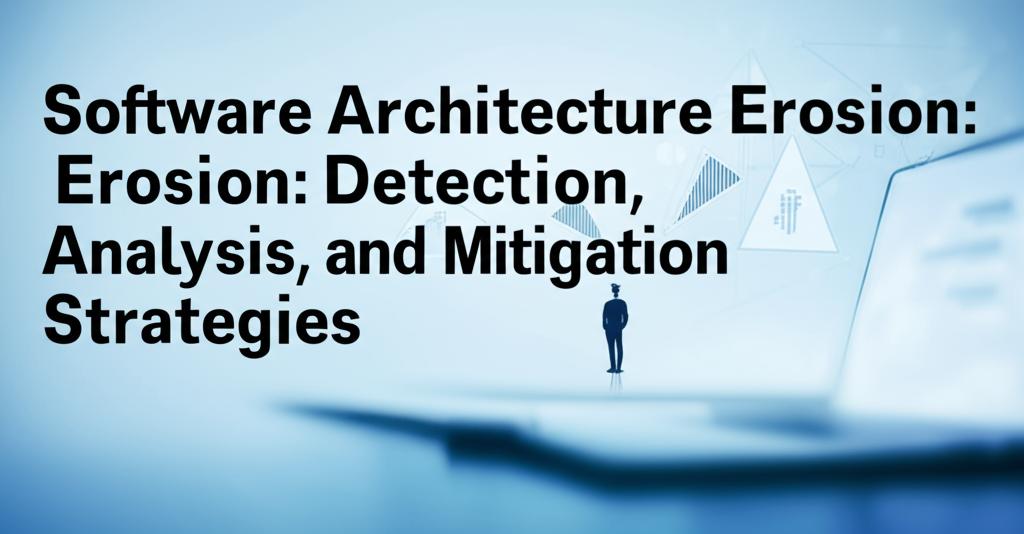Software architecture erosion describes the gradual divergence between the intended design of a software system and its actual implementation over time. As systems evolve with new features, bug fixes, and adaptations to changing requirements, decisions are often made that compromise the original architectural principles. This gap doesn't appear overnight; it's the result of accumulated changes, often made under pressure or without full consideration of the architectural blueprint. The consequences are significant, leading to increased complexity, reduced maintainability, lower quality, diminished performance, and higher development and maintenance costs.
Common Causes of Architecture Erosion:Several factors contribute to the degradation of software architecture:
- Accumulated Changes: Continuous modifications, feature additions, and bug fixes, especially when done without strict adherence to the original architectural design, are primary drivers.
- Time Pressure and Shortcuts: Development teams often take shortcuts or implement "quick fixes" to meet deadlines, leading to technical debt and architectural violations.
- Lack of Architectural Oversight: Insufficient involvement from architects during the development lifecycle, or a disconnect between architects and developers, can lead to implementations that drift from the intended design.
- Inadequate Documentation: Poorly documented or outdated architectural plans make it difficult for developers to understand and adhere to the intended structure.
- Evolving Requirements: Changes in business needs or technical environments can render parts of the original architecture suboptimal, but adaptations might be implemented inconsistently.
- Developer Knowledge Gaps: Developers may lack understanding of the original architectural principles or the long-term consequences of certain implementation choices.
- Design Defects: Flaws in the initial architecture design can inherently lead to erosion as developers work around these issues.
- Third-Party Libraries/Technology Shifts: Integrating new technologies or dependencies without careful architectural consideration can introduce inconsistencies.
- Inadequate Tools: Lack of proper tools for development, version control, or architectural analysis can hinder adherence to the design.
Early detection is crucial to prevent erosion from spiraling out of control. Several techniques can be employed:
- Continuous Monitoring & Assessment: Regularly comparing the implemented code against the intended architecture is fundamental. This involves architectural assessments to identify deviations, smells, and design problems.
- Code Reviews: Manual code reviews are effective in spotting architectural violations, duplicated functionality, unwanted dependencies, and other symptoms of erosion discussed among developers.
- Static Analysis: Automated tools can analyze source code to detect violations of predefined architectural rules, dependencies, and identify problematic structures like cyclic dependencies.
- Architectural Conformance Checking: Tools and techniques (like the Reflexion Model) specifically designed to compare high-level architectural models with the source code implementation help identify divergences and enforce constraints.
- Visualization Tools: Visual representations of the system's structure and dependencies can help architects and developers understand the current state and spot anomalies or degrading patterns.
- Symptom Analysis: Identifying common erosion symptoms like increased coupling, architectural rule violations, rigidity, or brittleness can act as early warnings.
- Machine Learning: Emerging approaches use ML to assist in detecting erosion patterns, architectural smells, or automating parts of the consistency checking process.
- Runtime Verification: Analyzing the system's behavior at runtime can detect dynamic violations that static analysis might miss, particularly in dynamic architectures.
Once potential erosion is detected, analysis is needed to understand its scope and impact:
- Identify Specific Violations: Pinpoint the exact locations in the code where architectural rules or principles are violated.
- Quantify the Deviation: Assess the degree of erosion, perhaps by measuring metrics like coupling, dependency violations, or the number of architectural smells.
- Impact Assessment: Determine how the erosion affects quality attributes like maintainability, performance, testability, and security.
- Root Cause Analysis: Investigate why the erosion occurred – was it due to technical constraints, lack of knowledge, process issues, or business pressure?
- Prioritization: Rank the identified issues based on their severity, impact on business goals, or cost to fix, deciding which areas require immediate attention.
- Cost-Benefit Analysis: Evaluate the effort required to fix specific erosion points versus the expected benefits in terms of improved quality or reduced future maintenance costs.
Combating architecture erosion requires a combination of preventative and corrective actions integrated into the development lifecycle:
- Continuous Architectural Improvement: Regularly assess the architecture, identify problems, and refactor to address them. This should be an ongoing process, not a one-off task.
- Architectural Refactoring: Dedicate specific time and resources to refactoring not just code, but the architecture itself, to correct deviations and improve design quality. Integrate this into development cycles (e.g., within sprints).
- Proactive Design: Employ modular design principles, componentization, and design patterns to create architectures resilient to change and easier to maintain.
- Strict Code Reviews: Implement rigorous code review processes focused not only on functionality but also on adherence to architectural guidelines.
- Automated Checks: Utilize static analysis tools, linters, and custom architectural conformance checks within the CI/CD pipeline to catch violations early.
- Clear Documentation & Knowledge Sharing: Maintain up-to-date, easily accessible architectural documentation and foster a culture where architectural knowledge is shared effectively among team members.
- Establish Architectural Governance: Define clear roles, responsibilities, and processes for making and enforcing architectural decisions.
- Upfront System Design Reviews: Conduct thoughtful design reviews before major changes or new feature implementations to ensure alignment with the architecture.
- Manage Technical Debt: Actively track and prioritize the repayment of technical debt, including architectural shortcuts.
- Embrace Simplicity: Strive for simplicity in both the architecture and the development process, actively eliminating unnecessary complexity.
- Proactive Maintenance: Implement regular software updates, automated monitoring, performance testing, and security audits to maintain system health.
Software architecture erosion is an inherent challenge in evolving systems. Ignoring it leads to decay, technical debt, and ultimately, systems that are difficult and expensive to maintain and enhance. By actively detecting, analyzing, and mitigating erosion through continuous assessment, refactoring, and disciplined development practices, organizations can ensure their software systems remain robust, adaptable, and capable of meeting future demands.

